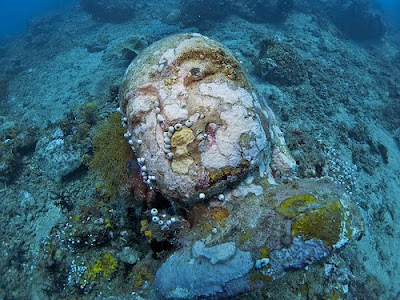 Statues of the Buddha photographed during a dive at an undersea temple, near Pemuteran, Bali (Robert Scales/Flickr.com)
Statues of the Buddha photographed during a dive at an undersea temple, near Pemuteran, Bali (Robert Scales/Flickr.com) TEMPLE GARDEN, Bali - At one time Theravada Buddhism extended throughout Indonesia, which has now become Muslim with the exception of Bali, which is largely Hindu and Buddhist.
TEMPLE GARDEN, Bali - At one time Theravada Buddhism extended throughout Indonesia, which has now become Muslim with the exception of Bali, which is largely Hindu and Buddhist.There among the island wonders, not far from Permuteran, is a spectacular set of ruins -- Buddhas under the sea.
Sea Rovers Dive Centre describes the site: This spooky location consists of a small temple complex starting at 30 meters and works its way back to the temple wall. Statues of the Buddha, the elephant-headed Hindu deity Ganesha, and sea turtles abound behind an ornate Balinese gateway.
 Behind the central statue is an interesting little bommie with Buddha heads covered in cleaning shrimps. Up the wall and in the crevices behind one can find electric clams sparking away. At 15 meters one comes to an area of plinths and statue heads sitting in communion.
Behind the central statue is an interesting little bommie with Buddha heads covered in cleaning shrimps. Up the wall and in the crevices behind one can find electric clams sparking away. At 15 meters one comes to an area of plinths and statue heads sitting in communion.But no Buddhist discussion of worlds under the sea would be complete without making reference to a strange thing the Buddha's foremost disciple in exercising psychic powers, Maha Moggallana, once said.
In the middle of the ocean
There are mansions aeon-lasting,
Sapphire-shining, fiery-gleaming
With a clear translucent lustre,
Where iridescent sea-nymphs dance
In complex, intricate rhythms
Great Moggallana knew this to be true from direct psychic experience. In a previous life he reports having had he says, "My body had the same form as a human body, but my head had the form of a fish's head."
Buddhist cosmology is replete with humanoid creatures, terrestrial and extraterrestrial. The Buddha inherited a rich Indian cosmology which he adapted. Was this simply pedagogical (used to teach) or was it an accurate description of our hidden cosmos?
 Devas ("shining ones" of many kinds from light beings to angelic aliens to elemental spirits and fairies), nagas (reptilian hybrids), asuras (rapacious titans), yakkhas (ogres), garudas (avian hybrids), kumbhandas (trolls, gnomes), petas (wretched phantoms), and others.
Devas ("shining ones" of many kinds from light beings to angelic aliens to elemental spirits and fairies), nagas (reptilian hybrids), asuras (rapacious titans), yakkhas (ogres), garudas (avian hybrids), kumbhandas (trolls, gnomes), petas (wretched phantoms), and others.
More importantly, there is a great "flood" that sweeps us away unawares, an ocean that overtakes us, a deluge that threatens to drown us in a pool of suffering: samsara.
- Happy Buddha (Jakarta, Indonesia)
- Beautiful Buddha (Sukhothai, Thailand)
































































































































































































































No comments:
Post a Comment